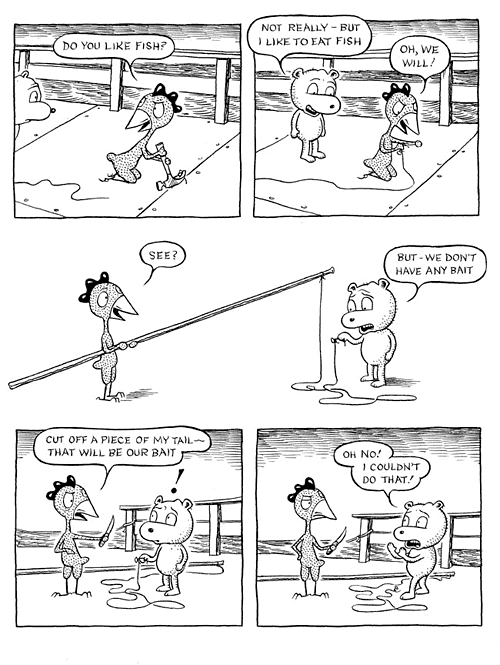It’s a pretty winning comedic formula: a cynical, embittered, occasionally venal guy paired with a naive, clumsy and perhaps not too bright counterpart. It’s a foundation that has served well for a lot of famous comedic duos. Laurel and Hardy, of course, but also to one degree or another Abbot and Costello, Jerry Lewis and Dean Martin, Gene Wilder and Richard Pryor, and Simon Pegg and Nick Frost, to name a few.
It’s a formula that cartoonist Ted Stearn has used repeatedly to good effect in his Fuzz and Pluck series of books, with Pluck the featherless chicken serving in the cynical smart-aleck role and sentient teddy bear Fuzz acting as the hapless but well-meaning foil. The third book in the series (if we can call it that at this point), The Moolah Tree, has just been released by Fantagraphics and finds Stearn continuing the rollicking absurdist comedy that typified the pair’s previous adventures, perhaps with some of the rougher edges filed off a tad.
The book picks up right where the last one left off, with Fuzz and Pluck adrift at sea and desperate for salvation and sustenance. It doesn’t take long, however, before they make way to an island where a tree that grows dollar bills instead of leaves is rumored to exist. While attempting to find the tree, they meet up with: an inept trio of pirates; a philosophic gypsy; a woman that obsessively collects unnecessary items, like popsicle sticks, and a donkey covered in flowers whose farts act like rocket fuel when it eats too many marshmallows.
There’s a ham-fisted moral throughout the book about money not being able to buy you happiness that’s virtually begging to come out. Stearn teases at this axiom several times, most notably via the aforementioned gypsy, but he manages to avoid coming off as patronizing or trite mainly to his absurd sense of humor, especially with a nod to high mortgage rates and our inflationary economy at the very end.
The world of Fuzz and Pluck is populated with deluded and frustrated characters and abounds in disturbing dreams and odd transformations. At one point in their quest to locate the tree, Fuzz and Pluck come across a swarm of angry bees, which ends with Fuzz covered in mud and Pluck swollen to twice his size in stings. There’s a frightening dream sequence early on where Pluck cuts off his legs in an attempt to make bait for fish and then Fuzz is torn by two stray threads asunder, until nothing is left of him but two eyeballs.
That Fuzz would have such an unsettling nightmare should should not be surprising to those who have read their previous adventures. Both Fuzz and Pluck and >Fuzz and Pluck: Splitsville had an element of horror to them, however slight. Think of their initial appearance with the cheesecake character that everyone ends up devouring. Or the creepy half-grapefruit villain in Splitsville. Or the little girl’s toys that tear off a duck’s wings in order to attach them to Fuzz (also from Splitsville).
And yet, odd dream sequence aside, Moolah Tree tones down a lot of that unsettling imagery to create a much more amiable, friendlier tale. The various characters here are more ridiculous than threatening, and while Stearn hasn’t lost any of his love of absurdist humor, a lot of the darkness has washed away in the bright sunlight of the genial island locale.
I missed some of those dark undercurrents, but my longing was appreciably undercut by Stearn’s stellar art work. He seems to be at the top of his game here, delineating sprawling mountains, forests and plains with thick layers of cross-hatching and ink. He has several stunning spreads, particularly a two-page spread where Fuzz and Pluck run for cover from the bees towards the corners of the page and a sequence where Pluck runs shamefully towards the edge of the page while angry word balloons threaten to envelop him. Even his page of a farting donkey taking off into the atmosphere is thick with scenery.
What started for Stearn as a surreal, more adult fable has shifted somewhat with The Moolah Tree into a rather amiable, attractive all-ages series, although I hasten to add it hasn’t lost any of its weirdness. The pr blurb for the book describes it as “Winnie the Pooh for adults” but I wouldn’t have any problem handing this title over to kids of a certain age (bloody chicken legs aside). They’ll certainly laugh at the farting donkey.









